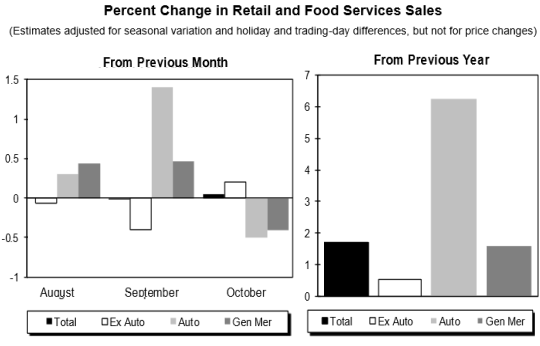Recession Watch: Looking at Retail Sales for Clues.
By Larry Kummer, editor of the Fabius Maximus website:
We watch the trend in retail sales because it shows how shocks in the US economy’s cyclical industries ripple outwards, first slowing sales growth — then pulling it down.
In April 2000 sales stalled; in March 2001 the recession began. There was no plateau before the Great Recession; sales peaked one month before the recession began. And now, according to the Commerce Department, October 2015 was the third month of flat retail sales; they’re down 1% (seasonally adjusted annual rate) since July excluding autos. Autos have been one of the strongest industries during the recovery. Excluding autos, retail sales are down year-over-year in real terms.
Auto sales have been a prop for the economy. They’ve been boosted by imprudent lending, with the average auto loan rising to $27,000 when the median household income of only $53,000, for an astonishing 65-month maturity — with 19.3% of auto loans going to people with subprime credit ratings.
The monthly volatility of auto sales makes trend changes difficult to see; this should be high on your list of things to watch. The inevitable crash in auto sales will be ugly, dragging down the entire economy. Automobiles have a higher multiplier effect on the economy than most retail products due to their size and complexity — consuming large amounts of raw materials and labor, requiring people to transport, sell, and finance them.
So far, as usual, the slowdown in the manufacturing sector has had only a minor effect on the economy. The goods-producing sectors employ only 14% of workers (of these only 12% work for manufacturers), while 70% work in the service sector and 15% for governments. The cyclical goods-producing sectors must slow a lot for the ripples to pull down the service industries. A fall in auto sales could provide such a push.
But not yet. Wards reports total unit sales; J. D. Powers reports average cost per vehicle sold. Both still look strong. But growing caution by either lenders or buyers could hurt sales. Bank regulators have expressed concern about subprime auto lending, especially on easy terms. As for consumers, auto sales are perhaps the largest expression of their “animal spirits” — a combination or reason and emotion vulnerable to so many things.
Recession Watch
There are many reasons to be watching for a recession in the next year. The age and weak magnitude of the recovery are both cautionary signals. Even more significant, real gross domestic income (GDI) on a seasonally adjusted annual rate basis has not just been below the 2% “stall speed” for the past 2 quarters but below 1%, an even stronger warning sign.
In 9 out of 11 post-WWII recessions, real GDI grew at 1% or less in at least one of the four quarters prior to the recession. The last time it did so in two consecutive quarters of Q2 and Q3 of 2012, which sparked the Fed to the third and largest round of quantitative easing (QE3).
What about the expected Fed action in December, starting the long “normalization” of interest rates? The Fed is capable of almost anything, certainly increasing rates in a weak economy and few signs of rising inflation. But I suspect they will do so only once, for the same reason children don’t touch hot stoves twice. These are not normal times. By Larry Kummer, editor of Fabius Maximus
The hidden key to regime change in the stock market. Read… Corporate Profits Are the Stock Market’s Foundation. What Will Break Them?
Enjoy reading WOLF STREET and want to support it? You can donate. I appreciate it immensely. Click on the mug to find out how:
![]()



I think the government should be tried and charged with economic sabotage with our economy .printing far to much money and setting interest rates far to low for far too long creating massive distortions .creating to bigger company’s. Massive over valuation of assets resulting in way way way way toooo much debt. We will all pay a very high price for there irresponsible policy. But the worst thing about it is the government will get away with it Scott free .I call it economic tresion people go to jail for much less than that I shack my head the more things change the more things stay the same.
But therein lies the problem Bruce! The FED is not a branch of the federal government. They are a banking Cartel and nothing more!
1926 – house prices softened
1927 – car sales dropped
1928 – construction levelled off
But in wall street the music still played until 1929.
Investors and markets are slow to react to the oncoming storm.
Retail is dead because the fashion business is currently obsolete. Everybody buys discount which is out of date by definition. We are all competing for the best deal which implies even more out of date. Fashion thrived on the latest thing and nobody cares about that anymore. Macys and Nordstom had bad numbers, not a surprise to me. Until incomes improve it will only get worse.
The status symbols now are smart phones, smart watches, grooming services, cars, vacations, and entertainment. All of these things have a high level of utility. People are only spending on those things they really use and enjoy.